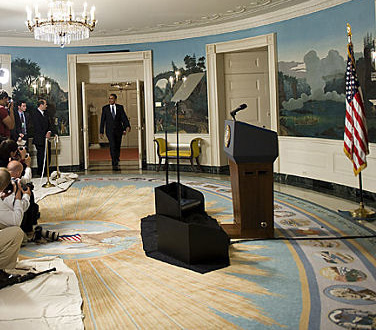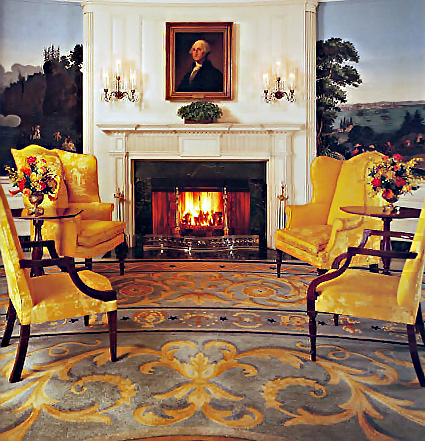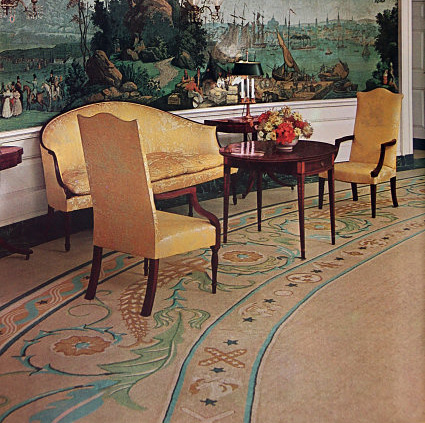2008: Obama Administration

Carpet description:
- Savonnerie-style (French)
- Custom-made in 1983
- Elliptical border
The Diplomatic Reception Room is one of three oval rooms in the White House and is the point of entry to the White House for a visiting head of state following the State Arrival Ceremony on the South Lawn. The room has four doors, which lead to the Map Room, the Center Hall, the China Room, and a vestibule that leads to the South Lawn. In 1960, a gold-and-white color scheme was chosen and the room was furnished as a drawing room of the Federal Period (1790-1820). It contains many fine examples of the cabinet craftsmanship from the Northeast states. A Regency chandelier of cut glass and gilt bronze was added in 1971. The striking panoramic wallpaper, called "Views of North America," was chosen by Jacqueline Kennedy in 1961 and was originally printed in 1834 Alsace, France. The complete set of 32 scenes, based on engravings of the 1820s, depict the Boston Harbor, the Natural Bridge in Virginia, West Point, New York, Niagara Falls, and the New York Harbor, landscapes that were particularly admired by Europeans.
The current rug, in shades of blue and gold, was specially woven for the room in 1983. Its border incorporates the seals or coats of arms of the fifty United States in an elliptical border. These border emblems are inspired by classical Etruscan and Roman motifs.
History of Savonnerie rugs
The early history of carpets in France is tied to the story of two weaving ateliers, Savonnerie and Aubusson. There are earlier references to carpets being woven in France before the seventeenth century, but no examples survive.
The granting of a license by Henri IV to Pierre Dupont in France, 1608, to manufacture Savonnerie carpets is similar in spirit to the establishment of court workshops by the Mughals and Safavids, whose common aim was to produce superlative works of art, including carpets. In 1627 Louis XVIII gave a royal privilege to Dupont (1577-1640) and his pupil Simon Lourdet (d.1671) for weaving carpets. They set up business in an old soap factory, hence the name Savonnerie, which quickly became the label attached to the products of the factory - carpets, panels and wall hangings - all created exclusively for the court. From the beginning, individual designers were employed to create designs, all of which were European in style.
Unlike early American or British carpets, no attempt seems to have been made by the Savonnerie atelier to emulate oriental carpets. A law was passed to prohibit the importation of carpets from the East to France in order to safeguard the Savonnerie workshop, which was granted a monopoly for the weaving of knotted-pile carpets. The seventeenth-century Savonnerie carpets have an opulent grandeur associated with them. Until 1768 the factory worked chiefly, if not exclusively, for the court, producing pile carpets only.
The richness of the colours used and the supremely confident manner with which acanthus scrolls, classical motifs and floral motifs were handled, combined to create a sumptuous effect worthy of any royal household. In 1663, Colbert, one of Louis XIV's ministers, stipulated that a painter from the Royal Academy had to oversee the designs for the carpets and to teach drawing to the staff every month. Several important painters were associated with Savonnerie in this way, notably Charles Le Brun and, later in the eighteenth century, Francois Boucher.
Austere state economies, due to the financial problems arising from the wars in the latter part of Louis XIV's reign, were largely responsible for the decline of the factory between 1690 and 1712. However, it was later revived and produced very pretty feminine carpets akin to the prevailing styles in the other decorative arts of the era. Soft colours, delicately drawn flowers, floral swags and ribbons are typical. Its heyday was over and by the beginning of the nineteenth century, cheaper Aubusson carpets became popular, although Napoleon employed the factory to weave handsome Empire-style carpets. In 1825, Savonnerie was amalgamated with the Gobelins tapestry factory and its independent existence came to an end. To read more about french style rugs and their history, visit our French Rugs section.
1975: Ford Administration

Carpet description:
- Reproduction of the previous signature seal rug
- Versace style
1963: Kennedy Administration

Carpet description:
- Custom-made Aubusson Carpet
- European (French)
- Influenced by antique classical trophies such as Etruscan and Roman motifs
Aubusson rugs
The Aubusson is a fine carpet woven in France from the 15th to the 19th centuries. Aubusson rugs were crafted with the assistance of architects and artists of the French royal court. They were originally made in France as a pile-less carpet with a floral medallion in pastel colors. Now, Aubusson rugs are woven in India and China with the addition of a pile. The Aubusson area was best known as an important tapestry-weaving center until great demand for knotted carpets provoked the installation of a carpet-weaving enterprise in the early 1740s. Initially the carpets were copies of imported Turkish designs with Louis XV being among the first clients. The demand for oriental rugs did not last, and the artist Pierre-Jose Perrot, who had already designed Savonnerie carpets, was called upon to design new carpets in the French style in 1750. The painter Le Lorrain produced a radical new design named "grande mosaique", which was a sophisticated precursor to the 19th century floral carpets. A central medallion of flowers is surrounded by dainty rosettes, flowers and garlands. Aubusson carpets were originally made as both knotted-pile carpets and later in the 18th century as flat woven, slit-tapestry carpets produced in the same way as their tapestries. The Aubussons that are popular and readily available today are typically flat weaves.
The Aubusson floral tradition was never completely abandoned, although the trend began to lean towards the neo-classical Empire style. That gave rise to elegant Savonnerie and Aubusson carpets, whose patterns are influenced by antique classical trophies or Etruscan and Roman motifs. These tend to be in a dark rich palette, sometimes in different shades of the same colour, resulting in a multi-dimensional look. Nineteenth-century Aubusson tapestry-woven carpets are popular today with interior decorators in Europe and North America. Trailing ribbons, bows and blowsy roses woven in soft pastel shades of rose, dovey greys, cafe-au-lait and pale yellows, conjuring a feminine look well suited for sitting rooms and bedrooms. Seventeenth and eighteenth-century Aubusson carpets in good condition are valuable finds - an Aubusson in good condition commands a very high price.
Sources and inspiration: Bérinstain, Valérie, et al. L'art du tapis dans le monde (The art of carpets in the world). Paris: Mengès, 1996. Print.; Jerrehian Jr., Aram K.A. Oriental Rug Primer. Philadelphia: Running Press, 1980. Print.; Herbert, Janice Summers. Oriental Rugs, New York: Macmillan, 1982. Print.; Hackmack, Adolf. Chinese Carpets and Rugs, Rutland and Tokyo: Tuttle, 1980. Print. ; De Moubray, Amicia, and David Black. Carpets for the home, London: Laurence King Publishing, 1999. Print.; Jacobsen, Charles. Oriental Rugs A Complete Guide, Rutland and Tokyo: Tuttle, 1962. Print.; Bashir, S. (n.d.). Personal interview.; Web site sources and dates of consultation vary (to be confirmed). Without prejudice to official usage.
Place an Order
We can reproduce any carpet shown on this page in the size and colors of your choice. For more information or to place an order, call us at +1-514-735-1958 from Monday to Saturday between 10 am and 5 pm Eastern standard time or feel free to e-mail us at [email protected]


 Tapis d'Orient Bashir | Bashir Persian Rugs
Tapis d'Orient Bashir | Bashir Persian Rugs
 @tapisbashir
@tapisbashir
 @bashircarpets
@bashircarpets
 @bashircarpets
@bashircarpets